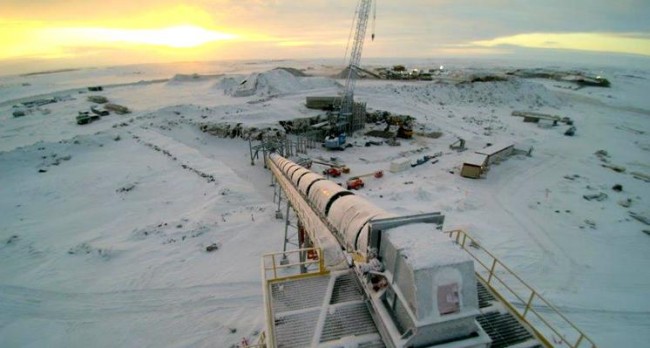
De Beers set to open huge N.W.T diamond mine; complex will employ 530
by Ian Bickis, The Canadian Press

Gahcho Kue mine will be among world's 10 largest diamond mines and bring jobs back to Canadian Arctic after Snap Lake closure last year

The Gahcho Kué complex is estimated to be one of the 10 largest diamond mines in the world. PHOTO: Mountain Province Diamonds
CALGARY—Canada’s position as a big player in the global diamond industry will be further crystallized Sept. 20 when it formally opens Gahcho Kue, estimated to be one of the 10 biggest diamond mines in the world.
The site will be the sixth diamond mine opened in Canada in the 18 years that the country has mined the precious stone. It sits about 280 kilometres northeast of Yellowknife in the Northwest Territories.
“It will be a very significant contributor to the NWT economy,” said Kim Truter, CEO of De Beers Canada, which co-owns the mine with Mountain Province Diamonds.
Truter said the operation will provide $6.7 billion to the Canadian economy over its estimated life span of 12 years and has generated $440 million to the territory’s economy so far.
Gahcho Kue is expected to produce about 4.5 million carats a year, which would make it one of the top 10 diamond mines by weight, according to research compiled by New York-based diamond analyst Paul Zimnisky.
Stornoway Diamond Corp. is also planning on opening a diamond mine in Quebec—which would be that province’s first—that it wants to bring to commercial production by the end of the year.
Canada’s diamond production is expanding at a time of growing volatility in the industry. Global sales of polished stones declined two per cent last year to US$24.7 billion as demand fell in emerging markets like India and China.
Lower prices and market instability meant a much bigger drop in the sales of rough diamonds, which dropped about 30 per cent to an estimated US$13.7 billion.
“Volatility is here to stay as global markets are likely to continue to fluctuate,” De Beers said in its 2016 market report.
The market conditions, combined with operational problems, forced De Beers to close its Snap Lake diamond mine in December last year at a loss of more than 400 jobs.
“It’s really, really important that these mining operations are competitive,” Truter said. “The problem with Snap Lake was it struggled to be competitive from day one.”
With Gahcho Kue only 80 kilometres southeast of Snap Lake, some have been able to find work at the new mine, which De Beers expects will need about 530 workers to operate.
Truter said the company has been working to share the benefits of Gahcho Kue with local First Nations and Metis, with impact benefit agreements signed with six groups in the area.
De Beers is also working to extend the life of its Victor mine in Ontario, but work on a potential expansion can’t move forward until it reaches an agreement with the Attawapiskat First Nation and other communities in the area.
While expansion work has been delayed for months, Truter said progress is being made.
“We’re working very closely with the local communities to get their support, and I think we are making positive progress,” he said.
But some community members feel they’ve been short-changed and are pushing for a better impact benefit agreement.
Charles Hookimaw, an Attawapiskat member who helped oversee the implementation of the agreement, said local businesses have had some small contracts, but overall the community has seen little benefit.
“We could have had more business opportunities here,” said Hookimaw.
He said he’d like to see some kind of revenue-sharing or part ownership of the mine and more benefits in general to the community.
Truter said the company spends about $70 million a year on local businesses in Attawapiskat and employs more than 100 full-time employees from the community, along with direct payments made as part of the impact benefit agreement. He said he hopes to be able to reach an agreement with the communities soon.
“We would obviously like to extend the life of Victor, because we really do want to keep the benefits flowing both to us as a company, but also to the community and to the government,” said Truter.